
Baixo Guandu is a municipality located in the Brazilian state of Espírito Santo that was founded on April 10, 1935 and established as a city on June 8, same year. The city's celebration day is April 10. Its population was 31,132 (2020) and its area is 918 km². The area is most well known for its exports of coffee, especially from the high mountains of the district of Alto Mutum Preto. The main watercourse through the municipality is the Rio Doce river whose basin is composed of 222 municipalities.

The Aimoré(Aymore, Aimboré) are one of several South American peoples of eastern Brazil called Botocudo in Portuguese, in allusion to the wooden disks or tembetás worn in their lips and ears. Some called themselves Nac-nanuk or Nac-poruk, meaning "sons of the soil". The last Aimoré group to retain their language is the Krenak. The other peoples called Botocudo were the Xokleng and Xeta.
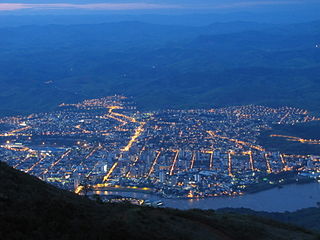
Governador Valadares is a Brazilian municipality in the countryside of Minas Gerais. In 2020, its population was 281,046 inhabitants, thus being the ninth most populated city in the state. It is an economical axis of the middle valley of the Doce River, having a significant influence on the east and northeast portion of Minas Gerais and local authorities of the state of Espírito Santo. Governador Valadares sits on the bank of the Doce River, 324 km from Belo Horizonte, the state's capital. Governador Valadares has an area of about 2 342 km2, of which only 58 km2 is urban area.
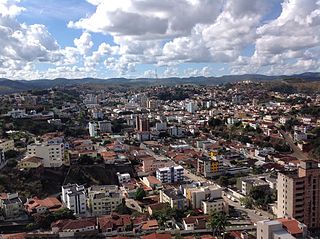
Teófilo Otoni is a municipality in northeast Minas Gerais state, Brazil. The population of the municipality was 140,937 in 2020 and the area is 3,242.818 km2.
Maxakalí is a Maxakalían language spoken in four villages in Minas Gerais, Brazil, by more than 2,000 people.
Pogonopoma wertheimeri is a species of armored catfish endemic to Brazil where it is found in the Mucuri River, São Mateus River, and Doce River. This species is usually found in stretches of river with mid to strong water current and bottom formed by rocks or sand. However, they are also found in the Juparanã Lagoon, close to the mouth of the Doce river, which is a lentic habitat. This species grows to a length of 22.3 centimetres (8.8 in) SL.
Microcambeva is a genus of catfishes of the family Trichomycteridae.
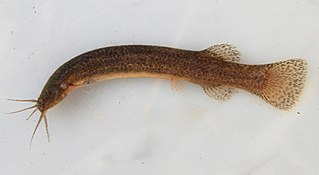
Ituglanis is a genus of small freshwater fish in the family Trichomycteridae native to South America. Their greatest diversity seems to occur in the Amazon River basin. Most species inhabit leaf litter, with several species living in caves.
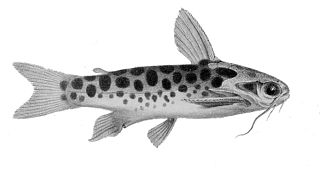
Tatia is a genus of small South American catfishes belonging to Auchenipteridae, the driftwood catfish family.
Centromochlus is a genus of fish in the family Auchenipteridae native to South America.
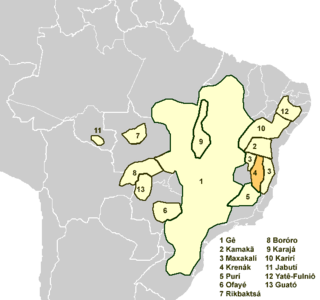
The Aimoré, Botocudoan or Borum languages, now sometimes known as Krenakan after the last one remaining, are a branch of the Macro-Jê languages – spoken mainly in Brazil – including moribund Krenak and extinct languages such as Guerén and Nakrehé. Loukotka (1968) considered them dialects of a single language, but more recent treatments describe at least some of them as separate languages.
Gelanoglanis is a genus of fish in the family Auchenipteridae native to South America.
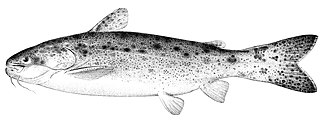
Glanidium is a genus of driftwood catfishes found in South America.
Glanidium leopardum is a species of driftwood catfish in the family Auchenipteridae. It is found in the coastal rivers of the Guianas in South America.
Glanidium albescens is a species of driftwood catfish in the family Auchenipteridae. It is found in the Das Velhas River basin in Brazil.

Glanidium ribeiroi is a species of driftwood catfish in the family Auchenipteridae. It is found in the Iguaçu River basin in South America.
Glanidium catharinensis is a species of driftwood catfish in the family Auchenipteridae. It is found in the Tubarão River basin in Santa Catarina, Brazil.

Glanidium melanopterum is a species of driftwood catfish in the family Auchenipteridae. It is found in the Piquete of São Paulo, Brazil.
Glanidium cesarpintoi is a species of driftwood catfish in the family Auchenipteridae. It is found in the Mogi-guassú River basin of São Paulo, Brazil.









